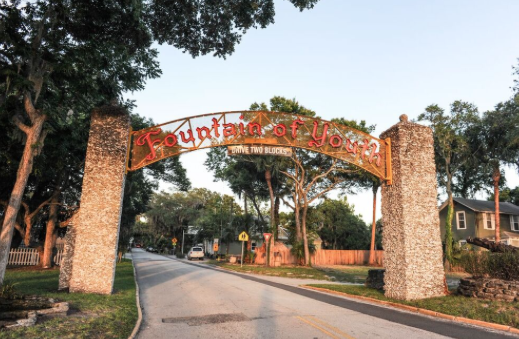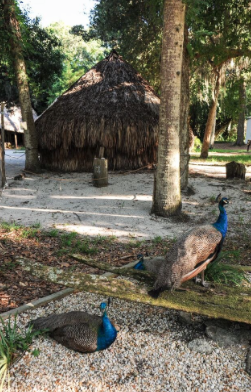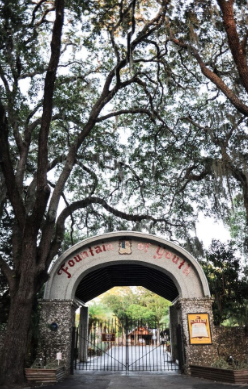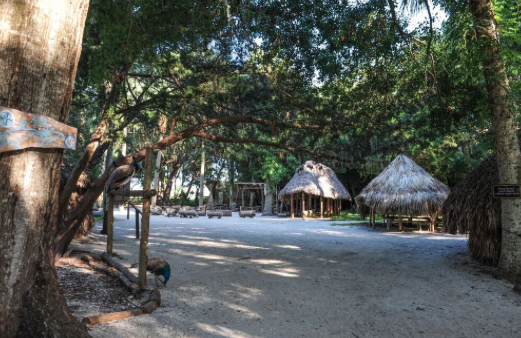
By Kara Pound
For thousands of years, civilization has narrated the story of the Fountain of Youth. A magical spring exists – it’s been said – that will restore the youth of anyone who drinks or bathes in its waters.
Imagine for a few moments what it would be like to have the wisdom that comes with age and the vitality and exuberance that comes with youth. And there you have the motivation and driving force behind Spanish explorer and conquistador Juan Ponce de Leon’s exploration of Florida in 1513.
In fact, Ponce de Leon was so obsessed with finding the vitality-restoring waters that he set sail from Puerto Rico and ultimately landed – as many historians believe – on the coastline of St. Augustine in what is now known as Ponce de Leon’s Fountain of Youth Archaeological Park.
 “The park itself has a fascinating duality,” says Kit Keating, communications manager for the Fountain of Youth. “The front of the park commemorates the landing of Ponce de Leon over 500 years ago. It is also a perfect example of a roadside attraction that pre-dates the giant mouse that ate Florida.”
“The park itself has a fascinating duality,” says Kit Keating, communications manager for the Fountain of Youth. “The front of the park commemorates the landing of Ponce de Leon over 500 years ago. It is also a perfect example of a roadside attraction that pre-dates the giant mouse that ate Florida.”
Keating is referring to Disney World, of course.
With a colorful and captivating history dating back more than five centuries, Fountain of Youth has remained a favorite place to explore in the Nation’s Oldest City – seeing approximately 175,000 visitors per year. It’s also Florida’s oldest attraction with signed guest books dating back to 1867.
From the park’s legendary muster of peacocks to the daily cannon firings to the re-creation of the Timucuan Village of Seloy, Fountain of Youth has a bit of something for everyone. So, starting in 1513 with Ponce de Leon’s discovery of an artesian spring thought to bring eternal youth, here is a rundown of the park’s history:
“The place was relatively untrammeled until September of 1565 when Pedro Menendez de Aviles came ashore here on a military mission,” says Keating of the post-Ponce de Leon days. “He was tasked by the king to destroy the French, who had set up shop about 40 miles north at Fort Caroline.”

In 1587, Fountain of Youth became the site for the first mission church built by the Franciscans. Today, Mission of Nombre de Dios has been reconstructed using local cypress, which was known to 16th century Spaniards to be durable and resistant to wood-eating insects.
Over the next few hundred years, the park was largely uninhabited or used for agricultural purposes. That is until 1868 when English florist H.H. Williams purchased the property and used it for the commercial cultivation of fruits and flowers.
“The artesian spring was free flowing as it had flowed for thousands of years,” Keating explains. “Williams wanted to control the springs, so he capped it and watered his lilies, irises and tropicals with water from the spring.”
In 1874, Williams opened the area to the public, but it didn’t become a tourist attraction until the early 1900s when Dr. Luella Day McConnell (aka Diamond Lil) purchased the land adjacent to the Matanzas Inlet and was instrumental in tirelessly promoting the area as the landing spot of Ponce de Leon in 1513.
McConnell claimed to have found a coquina cross in her garden measuring 15 stones tall and 13 stones wide with a silver salt cellar underneath containing a parchment paper authenticating Ponce de Leon’s landing.
The park’s next owner, Walter B. Fraser, an educator from Georgia who vacationed in Florida before relocating to the Nation’s Oldest City in 1927, saw the potential of St. Augustine to be a tourism venue and continued the work of McConnell to promote the Fountain of Youth as the birthplace of Florida.
But Fraser brought a new component to his brand of tourism, historic preservation. “He went to work in forming historical preservation committees and in helping birth tourism for St. Augustine for its historical value,” says Keating.

In 1934, the first archaeological dig took place on the park grounds. Over the past 80 years, everyone from the Smithsonian Institution to Yale University to the University of Florida have made discoveries on the 15 acres of history-rich land unearthing weaponry, jewelry and pottery.
Fraser ultimately passed control of the park to his son, John R. Fraser, who ran it for decades before his death in 2010 when his children took over. The brood has continued to make improvements to the park as a tourist attraction as well as work to maintain the historical integrity of the property’s past.
“The Fraser Family, in essence, became stewards of the land preserving it for future generations,” explains Keating. “Since 1927, the impact of the Fountain of Youth being a tourist attraction has been minimal and the owners greatly respect the archeological component of the property.”
While St. Augustine doesn’t appear to host waters possessing magical powers that bestow eternal youth and immortality, one thing is for certain. The springs that brought Ponce de Leon, hydrated the Timucuan Indians for a thousand years and served as the impetus for Menendez’s settlement has brought our little city a wealth of history, vitality and a whole lot of bragging rights.

Leave a Reply